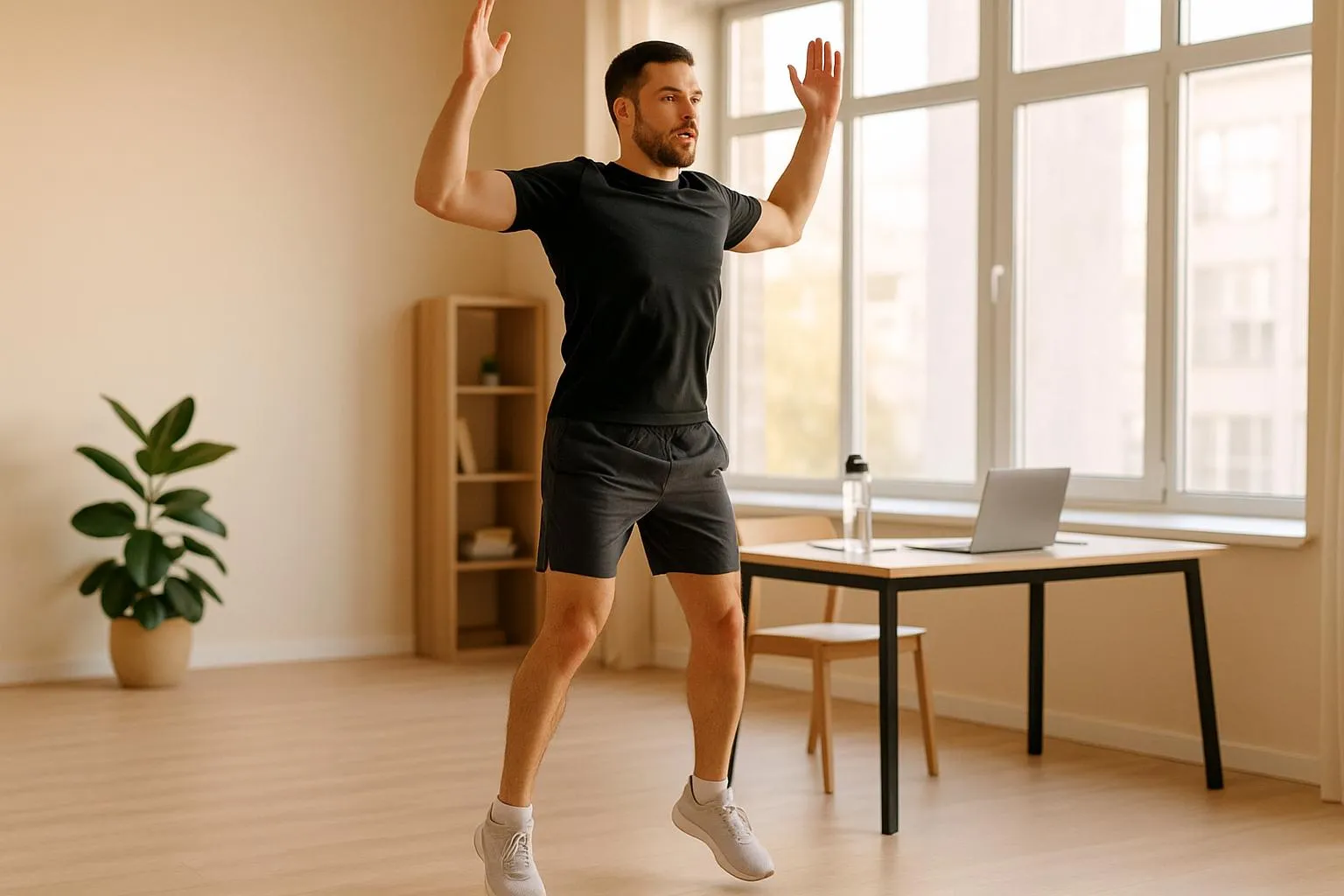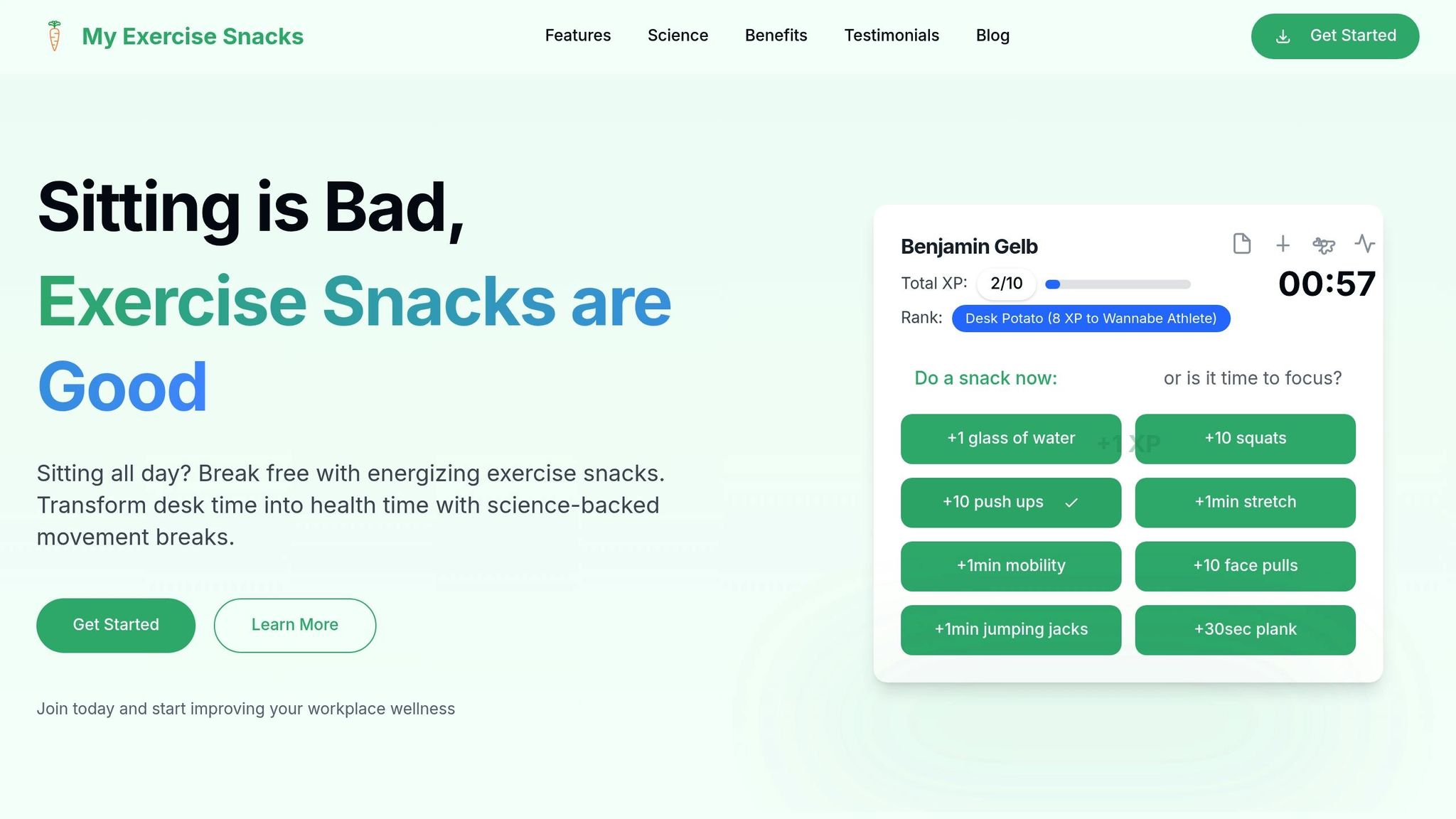
Exercise Snacks Huberman: Boost Focus, Reduce Stress & Improve Health
Want to improve your health without spending hours at the gym? Exercise snacks — short bursts of activity lasting 30 seconds to 5 minutes — might be the solution you need. Therefore, backed by neuroscience and experts like Dr. Andrew Huberman, exercise snacks can boost focus, reduce stress, and combat the health risks of sitting all day. Here’s what you should know:
- What are exercise snacks? Quick, simple movements like jumping jacks, stair climbing, or desk push-ups. No equipment or gym required.
- Why do they work? They break up sedentary time, improve cardiovascular and metabolic health, and enhance brain function by releasing chemicals like norepinephrine.
- Key benefits: Better focus, reduced stress, lower blood sugar, improved mood, and reduced risks of cancer and cardiovascular issues.
- How to start: Incorporate small movements into your workday — try standing meetings, desk stretches, or walking breaks.
Bottom line: Just a few minutes of movement throughout the day can significantly improve your health and productivity. In addition, start with what feels manageable and stay consistent!
Exercise Snacks to Improve & Maintain Fitness | Dr. Andrew Huberman
Science-Based Benefits of Exercise Snacks
The science behind exercise snacks highlights why these short bursts of activity are so effective for both your brain and body. Moreover, Dr. Huberman’s research points out that arousal likely accounts for 60–70% of the benefits exercise has on brain health, performance, and longevity. Consequently, whether you’re doing jumping jacks between meetings or sprinting up the stairs, you’re triggering biological processes far beyond calorie burning.
Improving Focus and Mental Performance
Exercise snacks act like a reset button for your brain. Furthermore, these quick bursts elevate your body’s arousal levels, directly improving focus and cognitive performance.
For example, doing 25 jumping jacks or 20 air squats can trigger adrenaline, which activates vagus nerve receptors. This stimulates brain regions responsible for releasing norepinephrine — a key chemical enhancing focus and memory.
Norepinephrine is your brain’s natural performance booster. It activates the prefrontal cortex for decision-making and strategic thinking, and the hippocampus for memory. As a result, this makes it easier to concentrate and tackle challenging tasks right after your mini workout.
Research supports this: high-intensity interval training (HIIT) before cognitive tasks significantly improves performance by increasing arousal and blood flow. For example, six 6-second sprints on a bike with 1-minute rests can enhance cognitive function.
Additionally, bone stress during exercises like jumping jacks, rope skipping, or high knees releases osteocalcin, a hormone promoting neuron growth. Consequently, this strengthens neural connections in the hippocampus, sharpening memory and learning.
Reducing the Harm of Sitting All Day
Exercise snacks don’t just boost brainpower — they also combat sitting’s negative effects. In addition, brief activity breaks improve cardiovascular health, increase endurance, enhance flexibility, build strength, and lower blood sugar.
For instance, short bursts of uphill walking — six 1-minute intervals at 90% of your maximum heart rate — can reduce post-meal blood sugar for up to 24 hours. Moreover, a 2014 study by Francois et al. found pre-meal exercise snacks lowered glucose after breakfast and dinner, with benefits lasting beyond activity.
The metabolic benefits are impressive. Just three short bursts of vigorous activity daily can lower cardiovascular death risk by 50% and cancer death by 40%. Dr. Joshua Beer explains:
“Short bursts burn more calories, increase metabolic rate, and improve endurance and strength — all in less time.”
These quick movements break up sedentary periods that lead to high blood pressure and high blood sugar. Additionally, Katie Lawton notes:
“Exercise snacks work as a reminder to get up and move every so often.”
Lowering Stress and Boosting Mood
Beyond focus and metabolism, exercise snacks manage stress effectively. They activate your relaxation response multiple times a day, creating a cumulative stress-reduction effect.
Activity releases endorphins, enhancing mood. Each snack helps your body transition from active to calm, strengthening stress recovery.
Mood improvements include lowering blood pressure, reducing fatigue, and improving overall mood. For example, even 15 minutes of running or an hour of walking daily can lower major depression risk by 26%. Furthermore, regular movement eases anxiety and ADHD symptoms.
Exercise snacks also improve mental clarity and productivity. Dr. Oppezzo says:
“People think they have to go to the gym every day to get a benefit, but even 60 seconds of vigorous movement counts.”
Ultimately, consistency is key. Regular movement prevents stiffness, lowers stress, and keeps energy steady. In addition, quick core exercises or compound movements can boost energy naturally.
How to Use Exercise Snacks at Work
Exercise snacks are practical for boosting energy, focus, and well-being during work.
Setting Up a Daily Movement Break Schedule
A consistent schedule makes exercise snacks a habit. Consequently, scheduling breaks can improve productivity and job satisfaction. The Pomodoro Technique — work for 25 minutes, then take a 5-minute break — is effective. Studies suggest walking breaks every 30 minutes maintain brain blood flow.
Block breaks on your calendar and set reminders. Cal Newport advises:
“Breaks are crucial to avoid burnout.”
Experiment with timing — morning bursts or post-lunch activity may work best. Once you find your rhythm, try desk-friendly exercises.
Simple Desk-Friendly Exercises
Quick, easy, no equipment needed:
- Hand and Finger Stretches
- Neck Rotations
- Desk Push-Ups
- Tricep Dips
- Seated Leg Raises & Ab Twists
- Chair Squats & Calf Raises
- Desk Plank
Eric Moogerfeld says:
“You can fit cardio and strength training into your workday.”
Making Movement Breaks a Habit
Identify natural breaks — arriving at work, before lunch, or during afternoon slumps. Moreover, treat them like appointments.
Use alarms or the My Exercise Snacks Chrome extension with reminders and gamified features.
Get creative: walk to a colleague instead of emailing, hold standing meetings, or do squats while microwaving lunch. Furthermore, share goals with coworkers or start a wellness challenge.
Dr. Alecia Gende reminds:
“You won’t regret the workouts you do.”
“Almost everything will work again if you unplug it for a few minutes…including you.”
Tools and Resources for Workplace Exercise Snacks
Technology can help turn intentions into habits.
How My Exercise Snacks Supports Wellness

My Exercise Snacks offers a free Chrome extension with AI reminders and gamification. The exercise library includes office-friendly routines with clear instructions.
Dr. Andrew Huberman says:
“Brief movement breaks are crucial for metabolic and cognitive health.”
Dr. Rhonda Patrick adds:
“Exercise snacks twice daily lower mortality risk.”
Using Technology for a Healthier Workday
Wellness programs save about $1.50 for every $1 spent. Consequently, wearables and apps track activity, set goals, and send reminders.
Cleveland State University uses WellSteps to reward activity. In contrast, the Superior Court of California fosters team competition.
Optum Workplace Well-being says:
“Digital solutions deliver measurable advantages for employees and organizations.”
Different Ways to Add Movement to Your Workspace
Office workers spend up to 80% of their time sitting. Therefore, movement-friendly spaces boost health and productivity.
Standing Desks
Standing for an hour daily at work can reduce upper back and neck pain by 54%.
Movement Stations
Designate areas for stretching or resistance bands.
Timer-Based Reminders
Set reminders every 30 minutes.
Walking Meetings
Walking meetings spark creativity and boost productivity.
Comparing Movement Methods
{{table:eyJoZWFkZXJzIjpbIk1ldGhvZCIsIkJlc3QgV29ya3NwYWNlIFNldHVwIiwiVGltZSBJbnZlc3RtZW50IiwiUGh5c2ljYWwgQmVuZWZpdHMiLCJQcm9kdWN0aXZpdHkgSW1wYWN0IiwiU2V0dXAgQ29zdCJdLCJyb3dzIjpbWyJTdGFuZGluZyBEZXNrIiwiQWRqdXN0YWJsZSBoZWlnaHQgd29ya3N0YXRpb24iLCIx4oCTMiBob3VycyBkYWlseSIsIlJlZHVjZXMgYmFjay9uZWNrIHBhaW4gYnkgNTQlIiwiTWFpbnRhaW5zIGZvY3VzIiwiJDIwMOKAkyQ4MDAiXSxbIkRlc2sgRXhlcmNpc2VzIiwiVHJhZGl0aW9uYWwgZGVzayB3aXRoIGNoYWlyIiwiMuKAkzMgbWludXRlcyBldmVyeSBob3VyIiwiSW1wcm92ZXMgY2lyY3VsYXRpb24gYW5kIGZsZXhpYmlsaXR5IiwiTWluaW1hbCBkaXNydXB0aW9uIiwiRnJlZSJdLFsiTW92ZW1lbnQgUmVtaW5kZXJzIiwiQW55IHdvcmtzcGFjZSBzZXR1cCIsIjMwIHNlY29uZHMgZXZlcnkgMzAgbWlucyIsIkJyZWFrcyB1cCBwcm9sb25nZWQgc2l0dGluZyIsIlF1aWNrIGVuZXJneSBib29zdCIsIkZyZWUgKGFwcHMvdGltZXJzKSJdLFsiV2Fsa2luZyBNZWV0aW5ncyIsIk9wZW4gb2ZmaWNlIG9yIG91dGRvb3Igc3BhY2UiLCIxNeKAkzYwIG1pbnV0ZXMgcGVyIG1lZXRpbmciLCJDYXJkaW92YXNjdWxhciBiZW5lZml0cyIsIkJvb3N0cyBwcm9kdWN0aXZpdHkiLCJGcmVlIl0sWyJNb3ZlbWVudCBTdGF0aW9ucyIsIkRlZGljYXRlZCBmbG9vciBzcGFjZSIsIjXigJMxMCBtaW51dGVzIGFzIG5lZWRlZCIsIkVuZ2FnZXMgbXVsdGlwbGUgbXVzY2xlIGdyb3VwcyIsIlByb3ZpZGVzIGEgbWVudGFsIGJyZWFrIiwiJDUw4oCTJDIwMCJdXX0=}}
Microbreaks: Simple Yet Effective
Short breaks like stretching or rolling shoulders increase brain blood flow. Therefore, Dr. Matthew Stork says:
“We need to rethink activity and get creative.”
Conclusion: Why Exercise Snacks Work for Office Health
Exercise snacks are rooted in science and offer practical solutions to modern office life challenges. Just 10 minutes of exercise can enhance mental focus and blood flow.
They trigger endorphins, serotonin, and neurogenesis, boosting cognitive function. Consequently, regular short breaks improve attention and executive functions.
Katie Lawton emphasizes:
“Consistency is key for daily movement.”
With inactivity costing billions annually, movement breaks boost job satisfaction quickly.
Simple strategies like desk stretches, walking meetings, and reminders integrate seamlessly into routines. Moreover, Dr. Marily Oppezzo says:
“Exercise snacks are ideal for busy people.”
With only 28% meeting activity recommendations, exercise snacks regulate blood sugar, lower diabetes risk, combat fatigue, and boost energy.
See more strategies in our guide on overcoming barriers to exercise at work and long-term health benefits of desk exercises.
FAQs
How can I add exercise snacks to my workday without disrupting focus or productivity?
These short bursts — climbing stairs, quick squats, or jumping jacks — take just 30 seconds to 5 minutes. Therefore, fit them into natural pauses without disrupting workflow.
What are the key benefits compared to longer workouts?
Exercise snacks improve heart health, build muscle strength, and sharpen mental performance without long time commitments.
What are some simple ways to remind myself to take regular breaks?
Set reminders on your phone or use fitness trackers. In addition, sticky notes and alarms can prompt you to move. Apps designed for short breaks send notifications to stretch or walk.
